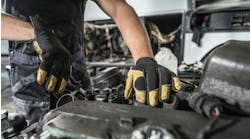Last week was National Tire Safety Week, a time when a spotlight shined on the importance of tires to the safe operation of vehicles. Largely aimed at the motoring public, the week seeks to get vehicle owners to do things like inspect the tread, check alignment and check tire pressure.
These same things apply to truck owners too. We know from our Confidence Reports on Tire Pressure Systems that correct tire inflation reduces tire wear, increases fuel efficiency, and leads to fewer roadside breakdowns due to tire failures. However, only 46% of all inspected tractor tires are within ±5 psi of the desired target pressure.
Reported impacts of tire underinflation include approximately a 5% to 12% degradation in tire wear for an individual tire which is 10 psi underinflated, and 0.5% to1.0% increase in fuel consumption for a vehicle running with all tires underinflated by 10 psi.
In addition, rolling resistance makes up 30% to 33% of the total fuel cost of a Class 8 truck or about $0.21 per mile. The typical purchase price of the tire is about $0.04 per mile, according to our Confidence Report on Low Rolling Resistance Tires.
Taking all this together and adding in the fact that many fleets are spec’ing low rolling resistance tires — where tire pressure is even more critical — it seems clear that fleets need to pay attention to tire inflation pressures not just during National Tire Safety Week, but all year long.
Tire monitoring and inflation systems are one way to ensure truck tires are properly inflated and therefore will not only help your fleet operate safely, but also improve your fuel economy. While I encourage all of you to look into these systems — our research shows they have a good payback — I’ve been around long enough to know you won’t all make the investment in them. But I do hope that you at least will make checking tire pressure a priority and remind your drivers to check tire pressure it each and every day. Proper tire inflation keeps trucks rolling safely… and economically.



